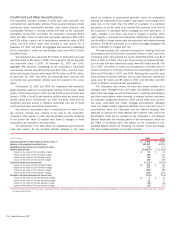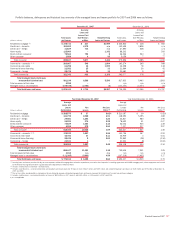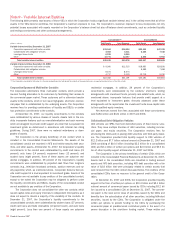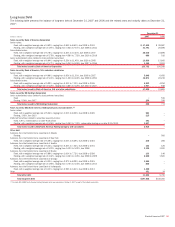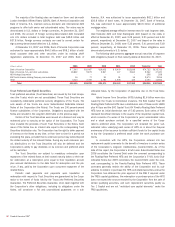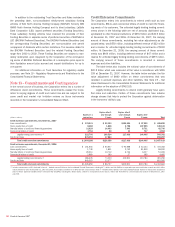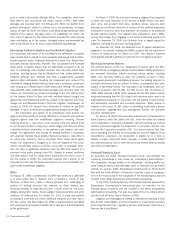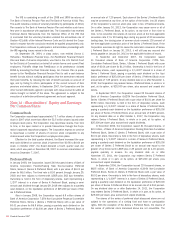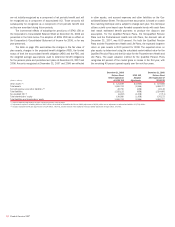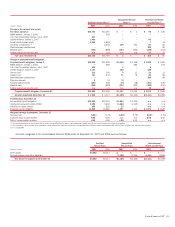Bank of America 2007 Annual Report Download - page 148
Download and view the complete annual report
Please find page 148 of the 2007 Bank of America annual report below. You can navigate through the pages in the report by either clicking on the pages listed below, or by using the keyword search tool below to find specific information within the annual report.Other Guarantees
Employee Retirement Protection
The Corporation sells products that offer book value protection primarily to
plan sponsors of Employee Retirement Income Security Act of 1974
(ERISA) governed pension plans, such as 401(k) plans and 457 plans. The
book value protection is provided on portfolios of intermediate/short-term
investment grade fixed income securities and is intended to cover any
shortfall in the event that plan participants withdraw funds when market
value is below book value. The Corporation retains the option to exit the
contract at any time. If the Corporation exercises its option, the purchaser
can require the Corporation to purchase zero-coupon bonds with the pro-
ceeds of the liquidated assets to assure the return of principal. To man-
age its exposure, the Corporation imposes significant restrictions and
constraints on the timing of the withdrawals, the manner in which the port-
folio is liquidated and the funds are accessed, and the investment
parameters of the underlying portfolio. These constraints, combined with
structural protections, are designed to provide adequate buffers and guard
against payments even under extreme stress scenarios. These guarantees
are booked as derivatives and marked to market in the trading portfolio. At
December 31, 2007 and 2006, the notional amount of these guarantees
totaled $35.2 billion and $33.2 billion with estimated maturity dates
between 2008 and 2037. As of December 31, 2007 and 2006, the
Corporation has not made a payment under these products, and has
assessed the probability of payments under these guarantees as remote.
Written Put Options
At December 31, 2007 and 2006, the Corporation provided liquidity sup-
port in the form of written put options on $10.0 billion and $2.1 billion of
commercial paper issued by CDOs, including $3.2 billion issued by a
consolidated CDO at December 31, 2007. The commercial paper is the
most senior class of securities issued by the CDOs and benefits from the
subordination of all other securities, including AAA-rated securities, issued
by the CDOs. The Corporation is obligated under the written put options to
provide funding to the CDOs by purchasing the commercial paper at pre-
determined contractual yields in the event of a severe disruption in the
short-term funding market. These agreements have various maturities
ranging from two to five years. The underlying collateral in the CDOs
includes mortgage-backed securities, ABS, and CDO securities issued by
other vehicles. These written put options are recorded as derivatives on
the Consolidated Balance Sheet and are carried at fair value with changes
in fair value recorded in trading account profits (losses). Derivative activity
related to these entities is included in Note 4 – Derivatives to the Con-
solidated Financial Statements. At December 31, 2007, the Corporation
held $5.0 billion of commercial paper on the balance sheet that was
issued by the unconsolidated CDOs and all of the commercial paper
issued by the consolidated CDO. The Corporation recorded losses of $2.7
billion, net of insurance, in trading account profits (losses) in 2007 asso-
ciated with these activities.
Indemnifications
In the ordinary course of business, the Corporation enters into various
agreements that contain indemnifications, such as tax indemnifications,
whereupon payment may become due if certain external events occur,
such as a change in tax law. These agreements typically contain an early
termination clause that permits the Corporation to exit the agreement
upon these events. The maximum potential future payment under
indemnification agreements is difficult to assess for several reasons,
including the inability to predict future changes in tax and other laws, the
difficulty in determining how such laws would apply to parties in contracts,
the absence of exposure limits contained in standard contract language
and the timing of the early termination clause. Historically, any payments
made under these guarantees have been de minimis. The Corporation has
assessed the probability of making such payments in the future as
remote.
Merchant Services
The Corporation provides credit and debit card processing services to vari-
ous merchants by processing credit and debit card transactions on their
behalf. In connection with these services, a liability may arise in the event
of a billing dispute between the merchant and a cardholder that is ulti-
mately resolved in the cardholder’s favor and the merchant defaults upon
its obligation to reimburse the cardholder. A cardholder, through its issuing
bank, generally has until the later of up to six months after the date a
transaction is processed or the delivery of the product or service to pres-
ent a chargeback to the Corporation as the merchant processor. If the
Corporation is unable to collect this amount from the merchant, it bears
the loss for the amount paid to the cardholder. In 2007 and 2006, the
Corporation processed $361.9 billion and $377.8 billion of transactions
and recorded losses as a result of these chargebacks of $13 million and
$20 million.
At December 31, 2007 and 2006, the Corporation held as collateral
approximately $19 million and $32 million of merchant escrow deposits
which the Corporation has the right to offset against amounts due from
the individual merchants. The Corporation also has the right to offset any
payments with cash flows otherwise due to the merchant. Accordingly, the
Corporation believes that the maximum potential exposure is not repre-
sentative of the actual potential loss exposure. The Corporation believes
the maximum potential exposure for chargebacks would not exceed the
total amount of merchant transactions processed through Visa and
MasterCard for the last six months, which represents the claim period for
the cardholder, plus any outstanding delayed-delivery transactions. As of
December 31, 2007 and 2006, the maximum potential exposure totaled
approximately $151.2 billion and $176.0 billion.
Brokerage Business
Within the Corporation’s brokerage business, the Corporation has con-
tracted with a third party to provide clearing services that include under-
writing margin loans to its clients. This contract stipulates that the
Corporation will indemnify the third party for any margin loan losses that
occur in their issuing margin to its clients. The maximum potential future
payment under this indemnification was $1.0 billion and $938 million at
December 31, 2007 and 2006. Historically, any payments made under
this indemnification have been immaterial. As these margin loans are
highly collateralized by the securities held by the brokerage clients, the
Corporation has assessed the probability of making such payments in the
future as remote. This indemnification would end with the termination of
the clearing contract.
Other Guarantees
The Corporation also sells products that guarantee the return of principal
to investors at a preset future date. These guarantees cover a broad range
of underlying asset classes and are designed to cover the shortfall
between the market value of the underlying portfolio and the principal
amount on the preset future date. To manage its exposure, the Corpo-
ration requires that these guarantees be backed by structural and invest-
ment constraints and certain pre-defined triggers that would require the
underlying assets or portfolio to be liquidated and invested in zero-coupon
146
Bank of America 2007


